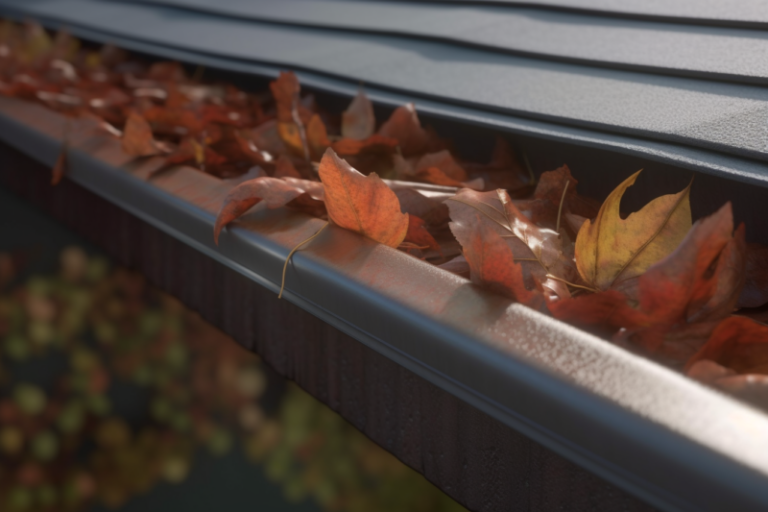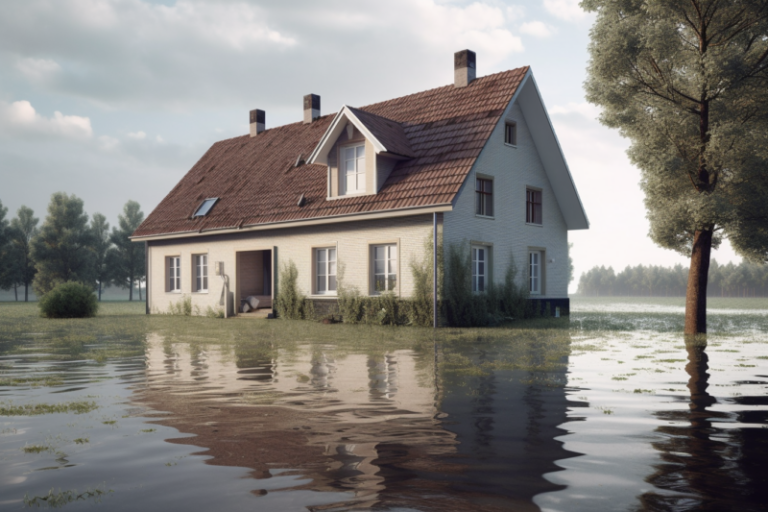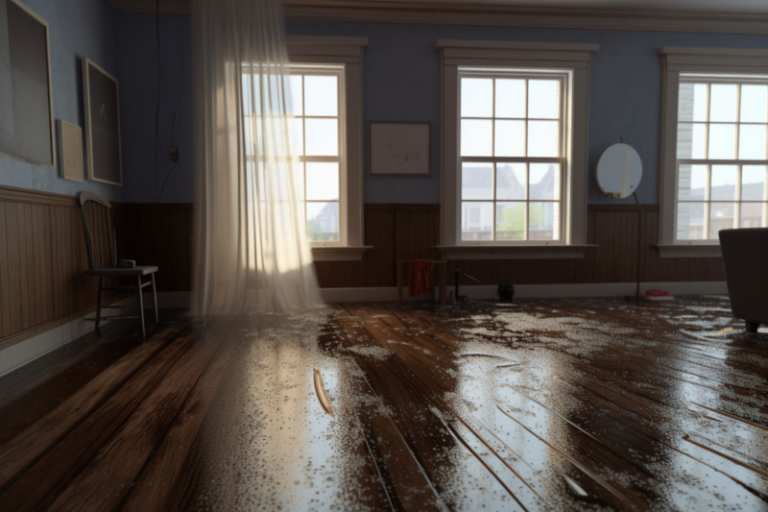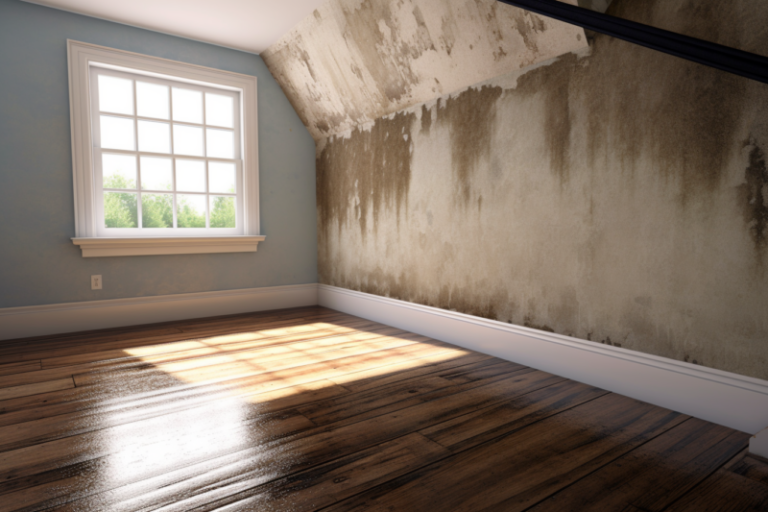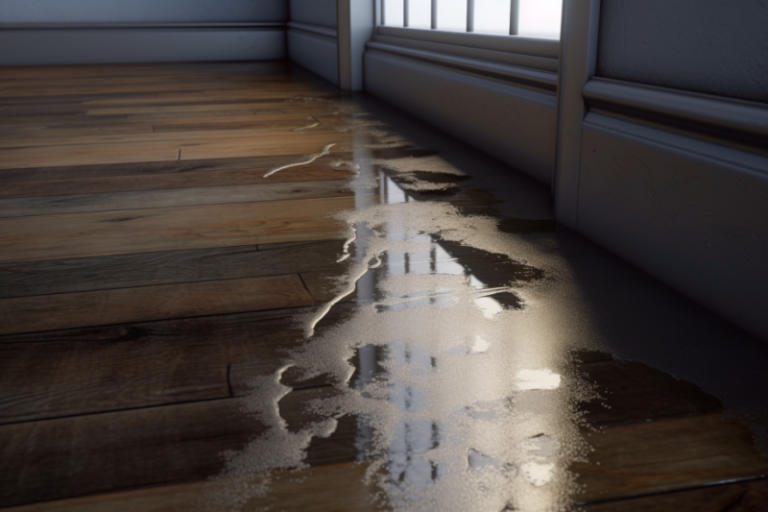Don’t Panic: Is Water Damage Reversible? Find Out Now!
Water damage can be a stressful experience for any homeowner. The thought of irreversible damage can be overwhelming.
But here’s the good news; in most cases, water damage is reversible. With the right approach, you can restore your property to its former glory. Let’s dive in and explore the options available to you.
Is water damage reversible:
Whether or not water damage is reversible depends on the extent of the damage and how quickly it is addressed. The sooner water damage is addressed, the better the chances of reversing its effects. However, factors such as the type of water, materials involved, and extent of the damage can also affect reversibility. Steps to reversing water damage include assessing the damage, stopping the water source, removing standing water, drying out the affected areas, disinfecting the area, and repairing or replacing damaged materials.
Water damage can be a nightmare for homeowners, but is it reversible? In this article, we’ll dive into the different types of water damage and how to remediate them.
Keep reading to learn how to avoid costly repairs and restore your home to its former glory.
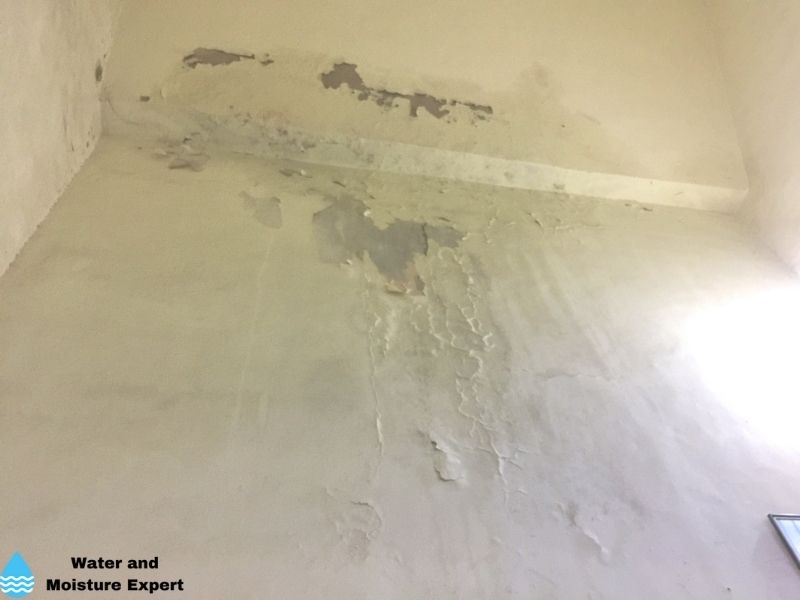
Contents
- 1 Is Water Damage Reversible?
- 2 Is Water Damage Permanent?
- 3 How Long Does It Take for Water Damage to Go Away?
- 4 Is Water Damage on iPhone Reversible?
- 4.1 • The Causes of Water Damage on iPhone
- 4.2 • Signs of Water Damage on iPhone
- 4.3 • Immediate Steps to Take After Water Damage Occurs
- 4.4 • Is Water Damage on the iPhone Reversible?
- 4.5 • Does Apple Cover Water Damage?
- 4.6 • How to Repair Water Damage on iPhone
- 4.7 • Prevention is Better Than Cure
- 4.8 • Conclusion
- 5 Can Water Damage Fix Itself Over Time?
Is Water Damage Reversible?
Water damage is a common problem that many homeowners and business owners face. Whether caused by natural disasters, plumbing leaks, or other sources, water damage can have serious consequences.
One of the biggest concerns associated with water damage is whether or not it is reversible.
• Understanding the Effects of Water Damage
Water damage can be caused by various factors, each of which can affect a property differently. For example, water damage caused by a sudden flood differs from that caused by a leaking pipe.
Similarly, the extent of the damage can vary depending on factors such as the amount of water involved, the length of time the water has been present, and the type of materials affected.
Regardless of the cause and extent of the water damage, however, it is essential to understand that water damage can have serious consequences. These include:
- Structural damage to the property
- Mold growth and other health hazards
- Electrical hazards
- Damage to personal property and possessions
• Can Water Damage Be Reversed?
Whether water damage can be reversed depends mainly on the extent of the damage and how quickly it is addressed. In general, the sooner water damage is addressed, the better the chances of reversing its effects.
For example, if a property experiences a sudden flood that causes water damage, it is essential to address the problem immediately. This may involve:
- Removing standing water
- Drying out the affected areas
- Removing any damaged materials (such as carpet or drywall)
By taking these steps quickly, it may be possible to reverse the effects of the water damage and prevent any lasting damage to the property.
• Factors Affecting the Reversibility of Water Damage
As mentioned above, the extent of the water damage and how quickly it is addressed are two critical factors in determining whether or not water damage can be reversed.
However, several other factors can affect the reversibility of water damage.
These include:
– Type of Water
The type of water involved can significantly impact the severity of the water damage and the ability to reverse its effects.
For example, water from a clean source (such as a broken pipe) may be easier to clean up than water from a contaminated source (such as sewage or flood water).
In some cases, contaminated water may require specialized cleaning procedures to remove all hazards.
– Materials Involved
The type of materials affected by the water damage can also affect its reversibility. For example, hardwood flooring may be more susceptible to water damage than concrete or tile flooring.
Similarly, materials such as carpet and drywall may need to be removed and replaced if they have been affected by water damage.
– Extent of the Damage
The severity of the water damage can also affect its reversibility. In some cases, minor water damage may be easily reversed with simple cleaning and drying procedures.
However, more extensive damage may require more involved cleaning and restoration processes.
• Steps to Reversing Water Damage
If you are facing water damage in your home or business, there are several steps you can take to help reverse its effects. These include:
– Assess the Damage
The first step in reversing water damage is to assess the extent of the damage. This may involve hiring a professional to conduct a thorough assessment of your property.
– Stop the Water Source
If the water damage is ongoing (such as a plumbing leak), stopping the water source as soon as possible is essential to prevent further damage.
– Remove Standing Water
If there is standing water, it must be removed as quickly as possible. This may involve using pumps or wet vacuums to extract the water.
– Dry Out the Affected Areas
Once the standing water has been removed, the affected areas must be dried out. This may involve using fans, dehumidifiers, or other drying equipment.
– Disinfect the Area
If the water involved is contaminated, it is essential to disinfect the area to prevent the spread of bacteria and other pathogens. This may include using specialized cleaning solutions and equipment.
– Repair or Replace Damaged Materials
Any materials damaged by the water (such as carpet, drywall, or wood flooring) may need to be repaired or replaced. This will help prevent further damage and ensure your property is safe and habitable.
• Conclusion
Water damage can be a severe problem for homeowners and business owners. However, if addressed quickly and effectively, many forms of water damage can be reversed.
By understanding the factors that affect the reversibility of water damage and taking steps to address the damage, you can help protect your property and prevent further damage from occurring.
If you need help addressing water damage, it is important to work with a qualified professional who can provide guidance and expertise throughout the process.
For more information on water damage and restoration processes, visit the Environmental Protection Agency website.
Is Water Damage Permanent?
Water damage is one of the significant concerns that homeowners and businesses face. Water damage can range from small spills to massive floods, and the water exposure duration can vary significantly.
Regardless of the cause, water damage can have devastating effects on buildings and properties.
One of the biggest questions homeowners and property owners ask is whether water damage is permanent. In this article, we will explore water damage and determine whether it is permanent.
• Understanding Water Damage
Water damage is the term used to describe the effects of water on building materials, including floors, ceilings, walls, and fixtures. Water damage can occur for various reasons, such as floods, leaks, plumbing issues, or weather-related incidents.
The extent of water damage can vary depending on the severity of the water exposure, the duration of the exposure, and the materials affected.
Water can cause discoloration, warping, cracking, and weakening of building materials. In severe cases, water damage can lead to structural damage, mold growth, and health hazards.
• Can Water Damage Be Reversed?
The answer to whether water damage is permanent depends on the damage’s severity. In some cases, water damage can be reversed, while in others, it may be permanent.
If the water damage is minor, such as a small leak, it can be easily repaired by drying the affected area and replacing the damaged materials.
In such cases, the water damage is not permanent, and the affected area can be restored to its original condition.
However, if the water damage is severe, such as a flood or a prolonged leak, it can cause substantial damage that may be irreversible.
In such cases, the water may have seeped into the building’s structure, leading to rotting, warping, and weakening of the materials. Such damage cannot be easily repaired, and the affected materials may need to be replaced.
• Factors That Affect Water Damage
Several factors can determine whether water damage is reversible or permanent. These factors include:
– The Source of the Water
The source of the water can significantly affect the severity of water damage. If the water comes from a clean source, such as a broken pipe, it can be easier to repair and restore the affected area.
However, if the water comes from a contaminated source, such as a sewer backup, it can lead to health hazards and require specialized cleaning and restoration.
– The Duration of Exposure
The duration of exposure is another critical factor determining the extent of water damage. The longer the water is left standing, the more severe the damage can be.
Prolonged exposure can lead to rotting, mold growth, and structural damage.
– The Type of Materials Affected
The type of materials affected can affect the severity of water damage. For instance, porous materials, such as drywall and carpet, can absorb water quickly, leading to warping and discoloration.
On the other hand, non-porous materials, such as tiles and metal, are less likely to absorb water and can be easier to dry and restore.
• Restoring Water Damage
Restoring water damage can be a complex and challenging process, depending on the severity of the damage.
It is essential to involve professional restoration services to assess the extent of the damage and recommend the appropriate restoration process.
Professional restoration services have the equipment, knowledge, and expertise to handle water damage effectively. They can extract the water, dry the affected area, and sanitize the space to prevent mold growth and health hazards.
– Do It Yourself (DIY) Restoration
Sometimes, homeowners or property owners may attempt to restore water damage on their own.
However, this can be risky, as they may not have the equipment and expertise to handle the damage effectively.
DIY restoration can lead to further damage, health hazards, and may ultimately require professional restoration services to rectify.
It is recommended that homeowners and property owners involve professional restoration services to assess and handle water damage. This can save time, money, and prevent further damage.
• Conclusion
In conclusion, water damage is not always permanent. The severity of the damage, the duration of exposure, and the type of materials affected can significantly affect the restoration process.
Minor water damage can be easily repaired, while severe water damage may require the replacement of the affected materials.
It is essential to involve professional restoration services to assess and handle water damage effectively. DIY restoration can be risky, and it is recommended that homeowners and property owners seek professional restoration services to avoid further damage and health hazards.
For more information on water damage restoration, visit the Federal Emergency Management Agency’s website.
How Long Does It Take for Water Damage to Go Away?
Water damage can be a nightmare for homeowners and businesses. It ruins your property and puts your health and safety at risk. The question is, how long does it take for water damage to go away?
The answer is not straightforward, as it depends on several factors. In this article, I’ll discuss those factors and provide some useful tips to speed up the recovery process.
• The Factors That Affect Water Damage Recovery Time
Here are some of the critical factors that can influence how long it takes for water damage to go away:
– The Severity of the Water Damage
The severity of the damage determines how long it will take to recover. If you’re dealing with a small leak, it may take only a few days to dry out the affected area.
But if you have extensive flooding, cleaning up and repairing the damage could take weeks or months.
– The Type of Water Involved
The type of water that caused the damage can also play a role in the recovery process. If the water was clean and free of any contaminants, it’s much easier to clean up and dry out the property. However, if the water is contaminated with hazardous materials, cleaning up and repairing the damage can take longer.
– The Type of Materials That Were Damaged
Different materials react differently to water. For example, wood and drywall absorb moisture quickly and can be easily damaged.
Carpet and upholstery can also be difficult to dry out, especially if they’re heavily saturated. On the other hand, metal and concrete are more resistant to water damage and may require less time to dry out and repair.
– The Presence of Mold
If water damage is not addressed promptly, it can lead to mold growth. Mold spores can start to develop within 24-48 hours after exposure to moisture.
Mold can be a severe health hazard, and addressing it as soon as possible is important. However, mold remediation can take longer than water damage restoration, as it often involves removing and replacing affected materials.
• Tips to Speed Up Water Damage Recovery
Now that you understand the factors that can affect water damage recovery time, let’s take a look at some tips to speed up the process:
– Act Quickly
The most important thing you can do when dealing with water damage is to act fast. The longer you wait, the more damage will be done, and the longer it will take to recover.
As soon as you notice water damage, immediately address the problem. This could mean calling a professional restoration company or taking steps to dry out the affected area.
– Remove Excess Water
The first step in the water damage restoration process is removing excess water. This can be done using pumps, shop vacuums, or other specialized equipment.
The faster you remove the water, the faster you can start drying out the property.
– Dry Out the Affected Area
Once you’ve removed excess water, it’s important to dry out the affected area as quickly as possible. You can use fans, dehumidifiers, or heaters to speed up the drying process.
Monitoring the humidity levels and ensuring they stay below 60% is important.
– Disinfect and Sanitize
After water damage occurs, it’s important to disinfect and sanitize the affected area to prevent mold growth and bacterial infection. This can be done using bleach, hydrogen peroxide, or commercial disinfectants.
• Conclusion
Water damage can be a stressful and challenging experience, but it’s important to act quickly and take steps to address the problem.
The time it takes for water damage to go away depends on several factors, including the severity of the damage, the type of water involved, the type of materials that were damaged, and the presence of mold.
By following the tips outlined in this article, you can speed up the recovery process and get your property back to its pre-damaged state as quickly as possible.
For more information about water damage restoration, check out Wikipedia’s article on the topic.
Time Frame | Severity of Water Damage | Remediation and Drying Process |
|---|---|---|
Within minutes | Category 1: Clean Water | Quickly remove standing water and increase ventilation to dry affected areas. |
Within hours | Category 2: Grey Water | Remove any contaminated items and begin cleaning and disinfecting affected areas. |
Within 1-2 days | Category 3: Black Water | Complete removal of affected materials and thorough cleaning and disinfecting. Professional drying and dehumidification may also be necessary. |
Long-term damage | Untreated water damage | Untreated water damage can lead to mold growth, structural damage, and health hazards. It is important to address any water damage as soon as possible. |
Is Water Damage on iPhone Reversible?
iPhones are expensive, and many of us are simply addicted to them. They are more like a part of our life; we cannot imagine our life without them.
iPhones are quite durable, but they are still prone to water damage. Unfortunately, water damage to an iPhone is a common problem many users face. In this article, we will discuss whether water damage on iPhone’s is reversible or not.
• The Causes of Water Damage on iPhone
Before we discuss whether water damage on iPhone’s is reversible, let us first look at why iPhones get water damage.
- Dropping the phone in water – We all have accidentally dropped our phones in water at some point. Be it a bowl of water, sink, or toilet; water can quickly seep into your phone, causing significant damage.
- Exposure to moisture – Even if you have not dropped your phone in water, moisture can still seep into your phone while using it in a humid environment, such as during showering or when sweating heavily.
- Manufacturing faults– In rare cases, manufacturing defects in the iPhone can cause water damage. In this case, you can claim your warranty from Apple.
• Signs of Water Damage on iPhone
The signs of water damage on the iPhone are quite apparent. Here are some of the most common ones:
- Dampness under the screen
- Water droplets inside the camera lens
- Problems with charging – iPhone won’t charge, or charging ports are malfunctioning.
• Immediate Steps to Take After Water Damage Occurs
If you have accidentally spilled water on your iPhone, here are the steps you should take immediately:
- Remove your phone case and take your phone out of the water immediately.
- Dry your phone with a clean cloth or towel.
- Do not turn on your phone – this will prevent further damage.
- Put the phone in a bag of rice and seal it shut. The rice will absorb the moisture.
- Keep the phone in the bag for at least 2-3 days.
• Is Water Damage on the iPhone Reversible?
The answer is no. Unfortunately, water damage is not an issue that can be solved by merely drying your phone out.
Water can cause significant damage to your phone’s internal components that cannot be rectified by drying it out. It can cause various problems, including:
- Short circuits
- Corrosion
- Water trapped within the device can cause rust, which can lead to further damage.
Water can cause extensive and irreversible damage to your iPhone if it is not treated immediately. It can cause problems with the battery, screen, motherboard, and more.
• Does Apple Cover Water Damage?
Apple’s warranty does not cover water damage to the iPhone. If your iPhone has been damaged by water or any other liquid, you will have to bear the cost of the repair.
Apple offers an AppleCare+ plan that covers accidental damages, but it comes with a premium. Also, even with AppleCare+, you will have to pay for the repair or replacement of the phone.
• How to Repair Water Damage on iPhone
Even though the water damage on the iPhone is not reversible, you can still repair it. Here are some options to repair water damage:
- Apple Authorized Service Provider – If you have AppleCare+, you can take your iPhone to an Apple Authorized Service Provider for repair. They will replace the damaged parts or replace the phone altogether.
- DIY methods – There are several DIY methods that you can use to fix your water-damaged iPhone, but they are not foolproof. Some of the popular methods include using rice, silica gel, or kitty litter to dry out the phone.
- Third-party repair shops – There are several third-party repair shops that can fix your water-damaged iPhone. However, you should be careful while choosing a repair shop as they may use cheap or replica parts, which can further damage your iPhone.
• Prevention is Better Than Cure
The best way to deal with water damage on the iPhone is to prevent it from happening in the first place. Here are some tips to prevent water damage to your iPhone:
Invest in a waterproof phone case- A waterproof phone case is an excellent investment that can protect your iPhone from accidental water spills.
Waterproof your phone- There are several waterproof coatings available in the market that can protect your phone from water damage.
Keep your phone dry- Use a towel to clean your phone if it gets wet. Always keep your phone dry.
• Conclusion
In conclusion, water damage on the iPhone is not reversible, and it can cause significant damage to your phone’s internal components.
However, you can still repair it by going to an Apple Authorized Service Provider or using DIY methods.
The best way to prevent water damage to your iPhone is to invest in a waterproof phone case, waterproof coatings, and always keep your phone dry.
If you accidentally spill water on your phone, follow the immediate steps to prevent further damage, and do not try to turn on your phone.
Can Water Damage Fix Itself Over Time?
Water damage is one of the most common types of damage to homes and buildings.
Whether it is caused by a leaking roof, burst pipe, or natural disaster, water can cause significant damage to the structure and contents of a property.
Many people wonder if water damage can fix itself over time. In this article, we will explore this question and provide some expert insight on the topic.
• Understanding Water Damage
Before we can discuss whether or not water damage can fix itself over time, we need to understand what water damage is and how it occurs. Water damage is a term used to describe the damage caused by water intrusion into a property. This can be caused by a number of factors, including:
- Leaking pipes or appliances
- Flooding or storm damage
- Roof leaks
- Poor ventilation or humidity control
- Condensation and moisture buildup
When water enters a property, it can cause damage to the structure, as well as the contents of the property. This can include warping, rotting, and weakening of materials, as well as mold and mildew growth.
• The Effects of Water Damage
Water damage can have both short-term and long-term effects on a property. In the short term, water damage can cause immediate damage to the property, including:
- Structural damage, such as weakened walls, floors, and ceilings
- Electrical damage, such as short circuits and power outages
- Damage to personal belongings, such as furniture, electronics, and clothing
- Mold and mildew growth, which can be harmful to health
In the long term, water damage can lead to more serious problems, including:
- Foundation damage, which can be expensive to repair
- Continual mold growth, which can create a dangerous living environment
- Health problems, such as respiratory illnesses and allergies
• Can Water Damage Fix Itself Over Time?
The short answer to this question is no, water damage cannot fix itself over time. Water damage is a progressive issue that will continue to worsen until it is addressed.
However, there are some situations where water damage may appear to have fixed itself over time.
For example, if water damage was caused by a one-time event, such as a natural disaster, and the affected area was properly cleaned and dried, the damage may not progress.
However, if water damage is caused by an ongoing issue, such as a leaking pipe or poor ventilation, then the damage will continue to worsen until the underlying issue is fixed.
• How to Prevent Water Damage
The best way to prevent water damage is to take proactive measures to protect your property. Here are some tips for preventing water damage:
- Regularly inspect your roof for leaks and damage
- Check your plumbing and appliances for leaks and repair them promptly
- Install a sump pump in your basement to prevent flooding
- Keep gutters and downspouts clean and free of debris
- Ensure proper ventilation in damp areas, such as bathrooms and kitchens
- Use a dehumidifier to control humidity levels in your home
It is also important to have a plan in place for dealing with water damage if it does occur.
This may include having a professional water damage restoration company on speed dial, knowing how to shut off the water supply to your home or business in the event of a burst pipe or flood, and having a plan in place for evacuating your property if necessary.
• How to Fix Water Damage
If you do experience water damage in your property, it is important to address it as quickly as possible. The longer you wait to address water damage, the more serious the problem will become.
Here are some steps to take if you have water damage:
- Assess the damage and determine the source of the water intrusion
- Turn off the water supply to the affected area
- Remove any standing water from the property
- Dry the affected area thoroughly with a dehumidifier or industrial fan
- Remove any damaged materials, such as drywall or carpet
- Clean and disinfect the affected area to prevent mold growth
It is important to note that fixing water damage is not a DIY project. Water damage restoration is a complex process that requires specialized equipment, training, and expertise.
It is important to work with a professional water damage restoration company to ensure that your property is properly and thoroughly restored.
• Conclusion
In conclusion, water damage cannot fix itself over time. In fact, water damage is a progressive issue that will continue to worsen until it is addressed.
The best way to prevent water damage is to take proactive measures to protect your property and have a plan in place for dealing with water damage if it does occur.
If you do experience water damage, it is important to work with a professional restoration company to ensure that your property is properly and thoroughly restored.
For more information on water damage and restoration, we recommend visiting the official website of the Environmental Protection Agency (EPA) at www.epa.gov.
| Can water damage fix itself over time? | |
|---|---|
| Question | Answer |
| What is water damage? | Water damage is any damage caused to a property due to the penetration of water into the structure. This can be caused by flooding, leaking pipes, or high humidity levels. |
| Can water damage fix itself without intervention? | No, water damage cannot fix itself over time. The longer the water is left to sit, the more damage it can cause to the structure and materials. Mold, mildew, and bacteria can also begin to grow, further exacerbating the damage and creating health hazards. |
| What should I do if I have water damage? | If you have water damage, it’s important to act quickly to mitigate the damage. This can include extracting any standing water, removing wet materials, and drying out the affected area. In many cases, it’s best to seek the help of a professional water damage restoration company to ensure the problem is resolved properly. |

